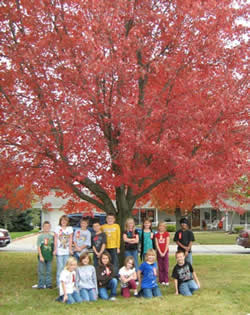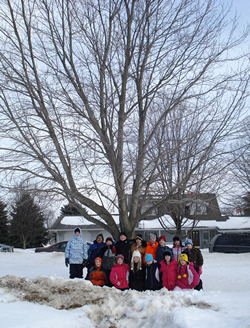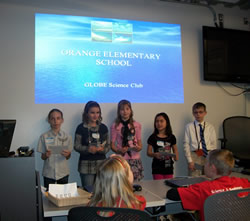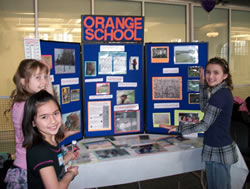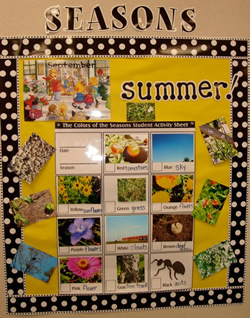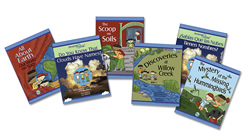Stars and STEM Stories
University of Northern Iowa Hosts Spotlight Day for Primary School Curriculum
The University of Northern Iowa (UNI) in Cedar Falls, Iowa, hosts an annual Spotlight on Science and Technology Day (Spotlight Day) to showcase authentic applications of math, science and technology in elementary school classrooms. Primary schools across the state are given the opportunity to present learning perspectives developed while utilizing GLOBE resources in the classroom. Spotlight Day emphasizes the need for hands-on, inquiry-based, interactive science, math and technology programs. The event was held on 25 February and sponsored by ITS Educational Technology. UNI Spotlight Day is a great opportunity to hear about science activities from other students and teachers, and as a result, everyone gains a fresh perspective on learning.
MFL MarMac Elementary School
Third grade GLOBE students from Mrs. Heidi Meyer's class at MFL MarMac Elementary School in Monona, Iowa, presented their year-long classroom study on plants. Mrs. Meyer's students integrated their research into other science, reading, writing, and technology activities. Their interdisciplinary approach focused on the life cycles and needs of plants, and included analyzing how plants change with the seasons. Students began collecting information by reading non-fiction books about plants, and taking a nature walk around the MarMac Elementary campus. Students drew and wrote observations in their science journals guided by the GLOBE Colors of the Seasons activity. Students tagged north, south, east, and west branches on an Amur maple tree, and made hypotheses about which branches would change first, or if they would all change at the same time. Five leaves on each branch were marked and each student in the class was responsible for observing their marked leaf. The GLOBE Color Guide was used to observe leaf color and observations were recorded in their science journals, including observations of leaves falling from the tree. In accordance with the GLOBE Plant Color Guide, students selected colored leaves that matched their observations and posted them on a pictograph. Once all of the leaves had fallen, the class evaluated the pictograph and noted that the leaves on the west branch had not only changed colors first, but had also fallen off first. This led to an in depth discussion in which both the students and their teacher formed the hypothesis that the sun bore down on the west side more than any other, causing the leaves to fall first.
As a final activity, students chose a plant they were interested in researching and ultimately presenting the findings of their investigations in a podcast to share with classmates and family. Some of the plants students chose for their podcast activity were a venus fly trap, a daisy, a rose, an aloe vera, a pitcher plant, a cobra lily, a tulip, a lily pad, a sundew, a willow tree, a redwood tree, a poppy and cattails. Students used books, magazines, encyclopedias, and online resources to research their plants. After students gathered facts about their plant, they wrote their information into a script for the podcast. They practiced reading their scripts to build fluency and recorded their podcast along with pictures on iPhoto using the GarageBand program, which allows users to create music or podcasts. "Their favorite part was selecting the music to add to their recordings," commented Mrs. Meyer. The students published their podcasts on their classroom wiki. Four students accompanied Mrs. Meyers to the Spotlight Day event to present their class projects on how they integrated science with technology using PowerPoint presentations they created. "It was a wonderful experience for the students to visit a college campus and to present in front of professors, teachers, and other students," Mrs. Meyer added.
Through the experience, students made connections between learning and their own actions, realizing how important it is for us to take care of our environment and protect Earth's resources. Many parents of the students presenting at UNI shared that their children were still excited even months after the event. GLOBE teacher Heidi Meyer has attended Spotlight Day for the past three years with different groups of students and has observed that "many GLOBE teachers share exceptional projects that they are teaching in the areas of science, math and technology." Mrs. Meyer summed up the event by asserting, "Spotlight Day is a great event to showcase GLOBE and the impact it's had on Iowa teachers and students."
Orange Elementary School
The GLOBE Science Club from Orange Elementary School in Waterloo, Iowa, coordinated by GLOBE Teacher Carol Boyce, meets monthly before school to enhance scientific knowledge through a variety of science and technology experts in the community. Five students from the club attended UNI Spotlight day to present their studies. Students prepared a presentation, highlighting activities and research they have done throughout the school year. Mrs. Boyce's science club conducted pH, Water Temperature, Surface Temperature, Max/Min/Current Air Temperature, Cloud, and Precipitation Protocols including measurement of both rain and snow throughout the year. The students' research focused on inquiry and investigations that incorporated GLOBE Protocols. Some of the students' inquiry based questions were: How do cattails in wetlands reproduce? How has the biodiversity of the soccer field changed since it was planted to prairie? How does the playground surface temperature compare to the temperature of the soccer field? Students also identified insects, birds and amphibians that inhabit the school yard to include as metadata.
Orange Elementary Students integrated technology in several ways, using the internet to report their data to the GLOBE Program, IOWATER, and the NatureMapping Foundation. The Science Club performed a climate study comparing four schools at their same latitude using GLOBE graphs. The students used GLOBE data from three other schools from their same latitude to gather data to create graphs, using GLOBE data to analyze how weather is the same or different at the same latitude as Orange Elementary School. Students also studied the arrival and departure dates of Hummingbirds, as well as a season study of a tree outside the school, providing information about Iowa's seasonal weather changes. Ms. Boyce commented that the GLOBE Program, "provides the skills, concepts and attitudes for our students in their quest to become practicing science professionals!"
Oskaloosa Elementary
GLOBE Kindergarten teacher Beth Hodges from Oskaloosa Elementary School displayed and presented her class work at Spotlight Day, with emphasis in integrating science in an early childhood classroom. Some GLOBE activities Mrs. Hodges and her Kindergarten students used throughout the year are the Hummingbird Protocol, The Colors of the Seasons and Zoom In and Zoom Out activities. The learning objectives for the lessons were: define and record observations of the changing seasons, identify seasonal characteristics as they observe the four seasons and recognize seasonal markers in our region.
Gathering to share how students and teachers are using GLOBE in their classrooms enhances the opportunity for collaboration within the GLOBE community. The UNI Spotlight on Science and Technology Day creates a sense of continuity among the partnership and GLOBE Schools in Iowa.
In addition to students' increasing comfort with technology and utilization of hands-on GLOBE Protocols, Elementary GLOBE is visually stimulating and quite useful in cross-curricular GLOBE studies in elementary level classrooms. These books are designed to introduce students of grades K-4 to the study of Earth System Science (ESS). Elementary GLOBE forms an instructional unit comprised of five modules that address ESS and interrelated subjects including weather, hydrology, phenology, and soils. Each Elementary GLOBE module contains a science-based storybook and classroom learning activities.
Read more about important student research in Iowa:
GLOBE Iowa 7th Graders Continue Volga River Research Project
A Meeting of Minds: GLOBE Students and Scientists Share Research in Iowa
A Student's Question Leads to National Award, IA, USA
22 June 2011






